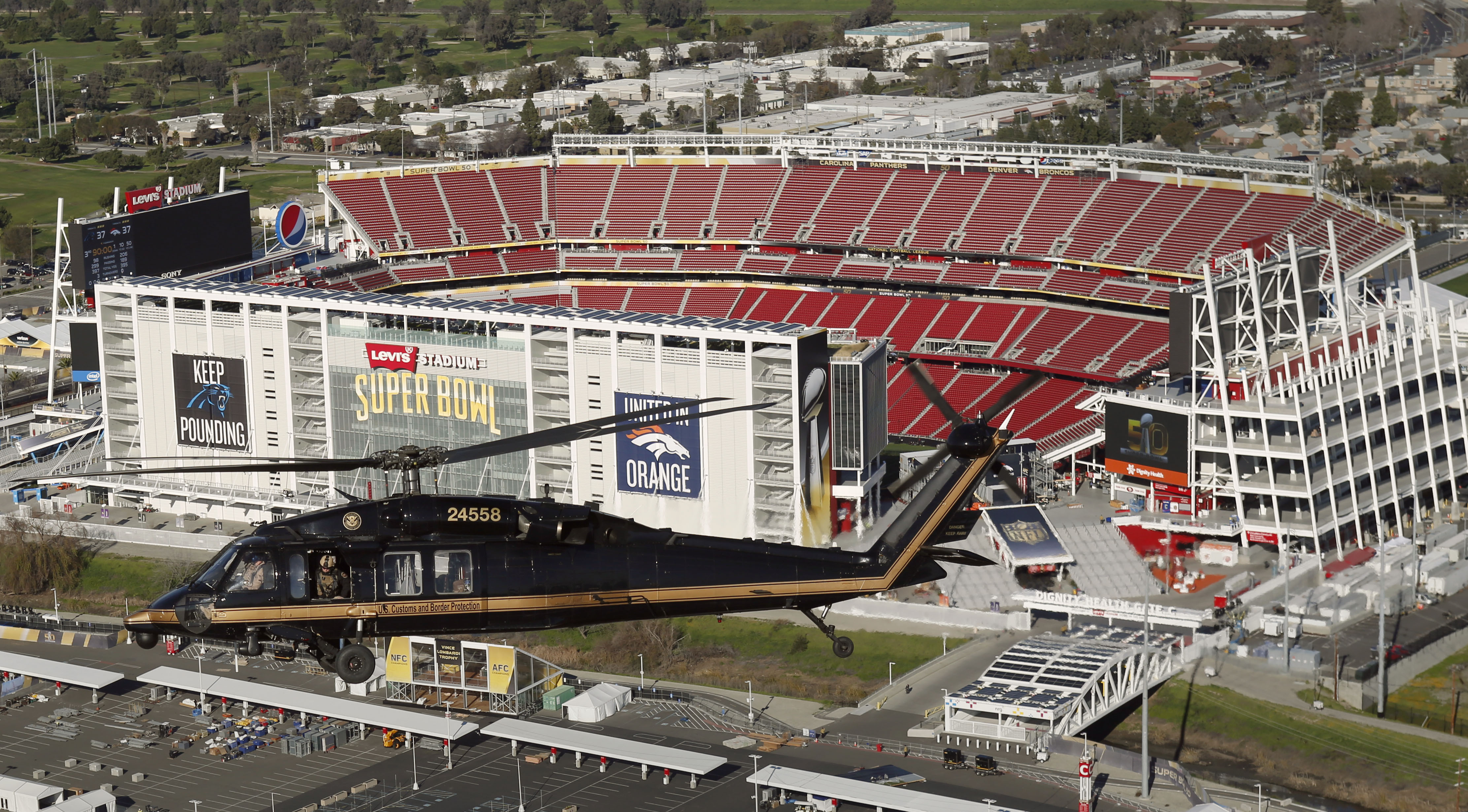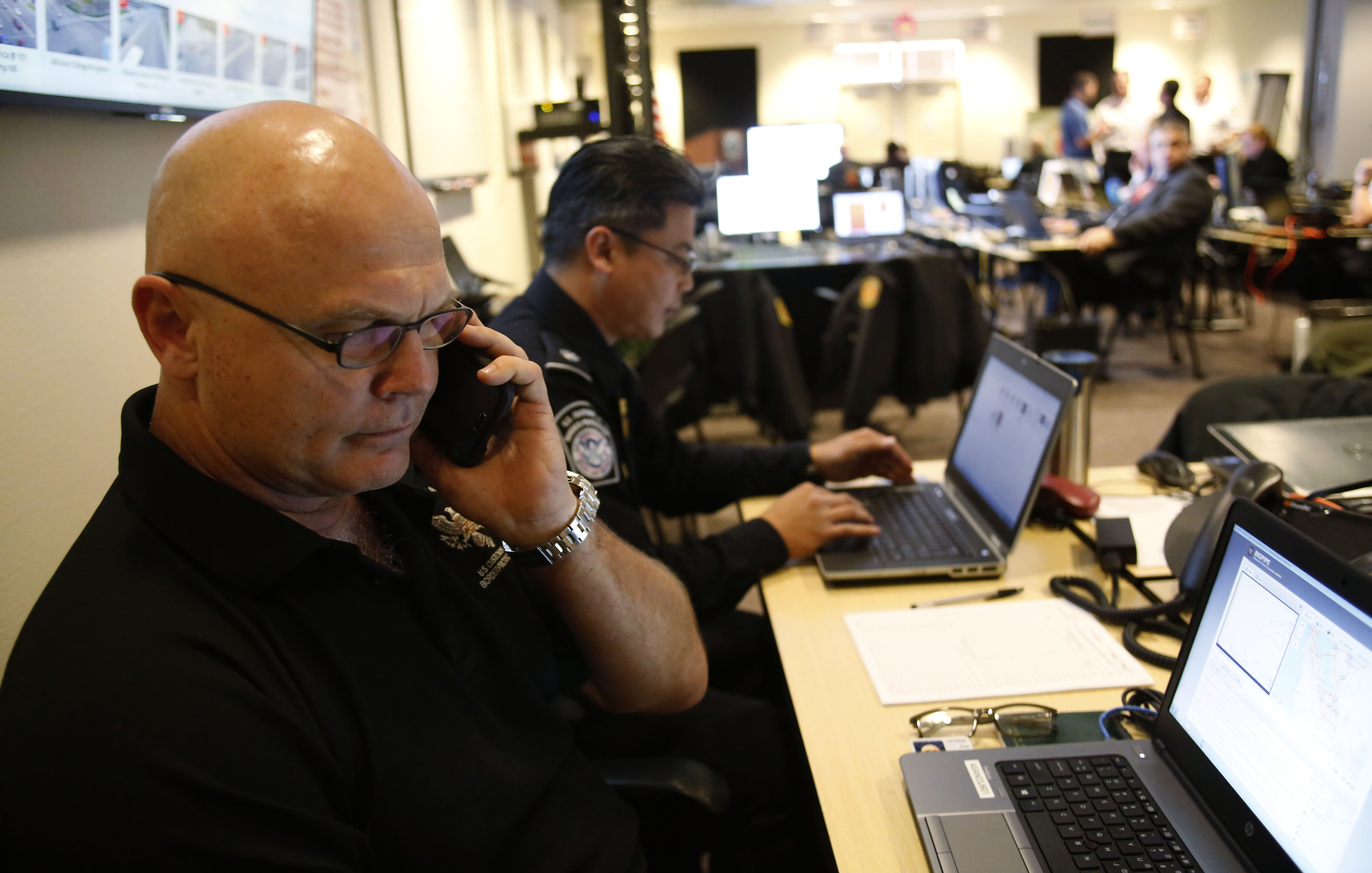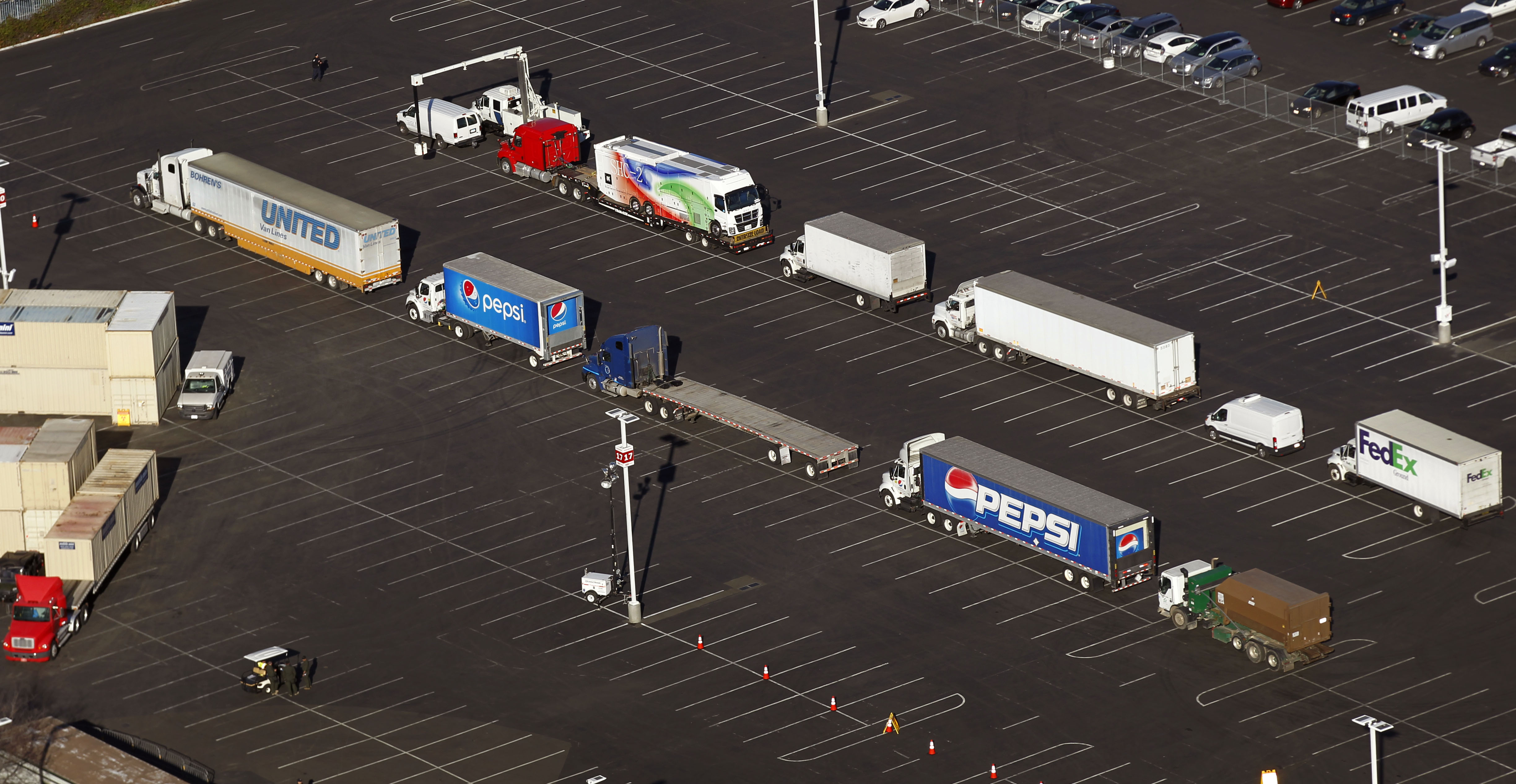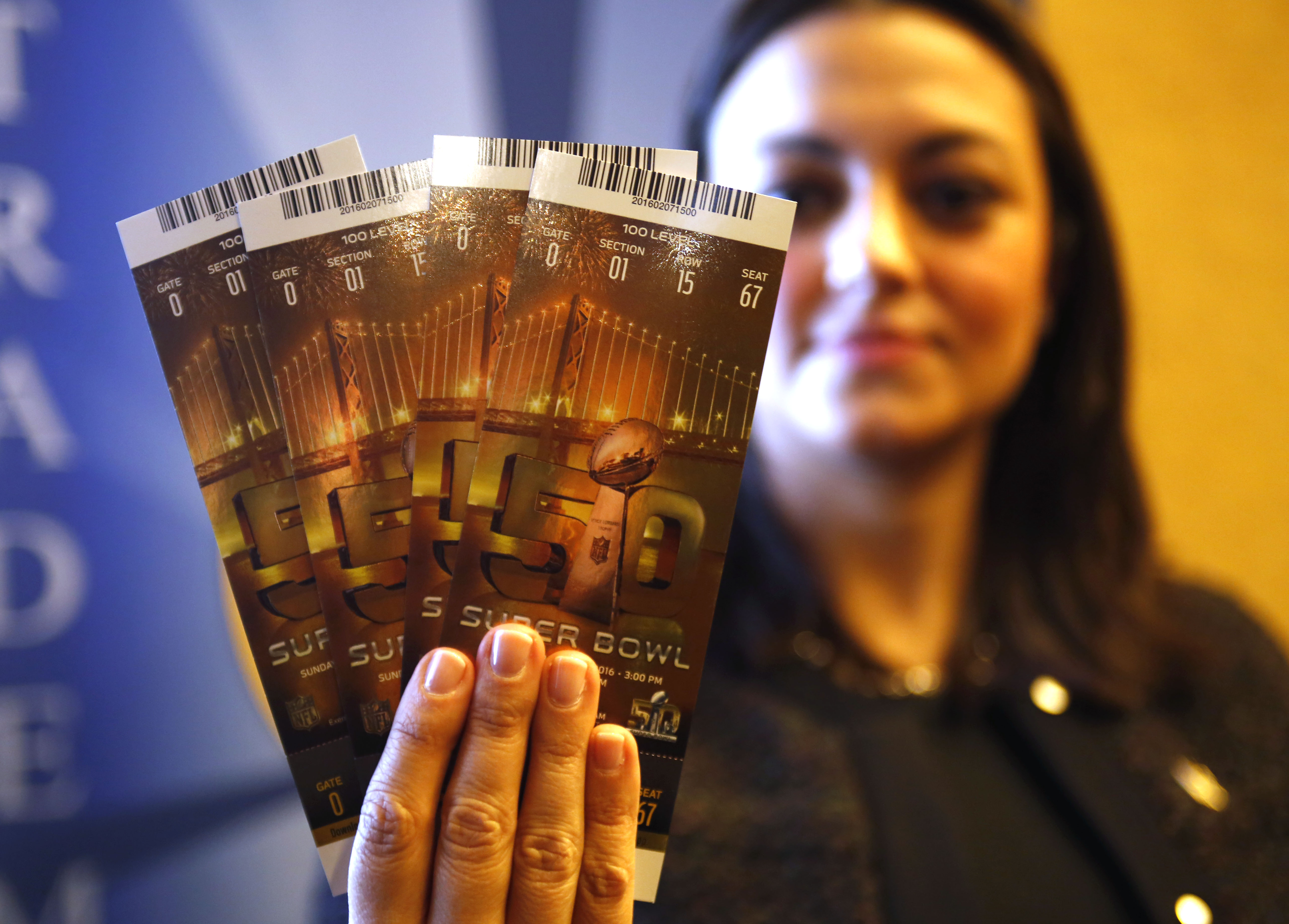
Game Over

A CBP Air and Marine Operations Blackhawk helicopter strikes a commanding presence above Levi's Stadium in Santa Clara, California, site of NFL Super Bowl 50.
Super Bowl 50 tested the 129 U.S. Customs and Border Protection agents and officers who contributed to the event’s success. While there were no incidents and fans enjoyed the game without worrying about their safety, security didn’t come without obstacles.
“This was the largest event the NFL ever held,” said James Vick, CBP operations chief, OFO, during Super Bowl and program manager at the San Francisco Field Office. Although planning for Super Bowl 50 began right after Super Bowl 49, protecting the expected record crowds coming to celebrate a milestone half-century of championship football required a well-defined strategy.
Another challenge for CBP was the game’s location. Unlike the previous year’s Super Bowl in Phoenix where assets could be concentrated close by, in San Francisco they were stretched from the City by the Bay to Levi’s Stadium, in Santa Clara, nearly 50 miles away, said Vick.
“It was difficult because of the distance and traffic,” he said.
Then the terrorist attacks in Paris and San Bernardino by Islamic terrorists altered planning, requiring CBP, in partnership with FBI intelligence, to pause and determine what measures to take. “That changed things,” Vick noted. However, “the FBI was happy to have us.”
Super Bowl security was directed from three command centers, one just a few miles from the stadium, where CBP shared its expertise with local, state and federal law enforcement as well as military staff. Civilian components provided weather service and monitored electrical networks to detect tampering.
The centers coordinated ground and air assets and ensured essential equipment and supplies were delivered. Most importantly, the centers allowed the different agencies to communicate—the “big pipe” as it was called—explained Paul Kleine, a supervisory air interdiction officer.

The Santa Clara command center had two wall monitors, one a monster 12 feet by 5 feet, displaying real time video covering the region. Operators could spot incidents, such as traffic, an accident or a protest, for instance, and advise law enforcement or even game officials traveling from their hotel to the stadium.
Essential equipment included an X-ray machine suspended from a truck, mobile radiation portals, as they’re called. The machine was kept busy scanning truckloads of beer, bread, wine, furniture, lights, portable toilets and potato chips arriving at Levi's Stadium.
The portals could scan an entire tractor trailer or a small van in just a few minutes, delivering sharp images of their contents. Anything radioactive would also be detected. That could mean a possible explosive, or just granite or kitty litter. Those items emit natural radioactivity, said Officer Fred Ho.

If the portal detected radiation or a vehicle was suspected of carrying a bomb, it would be moved into a U-shaped barricade built from stacks of shipping containers filled with dirt. The structure was designed to contain any blast. Officers also carried small personal radiation detectors clipped to their service belt.
About 300 vehicles per day delivered goods right up until game time. None of that volume could be managed without the experience and equipment CBP brought to the staging area, according to Brian Humphrey, director of field operations, San Francisco Field Office.
A second CBP vetting operation was underway at San Francisco's Pier 54 from 1 a.m. to 9 a.m. Those deliveries supported Super Bowl City, a fan village built near the city's downtown waterfront and the NFL Experience, a football interactive theme park fabricated across from San Francisco’s Moscone Center.
"The most exciting thing is the technological support we bring to law enforcement," Humphrey said. "No other law enforcement operation or private entity has our capability."
Then there was security from the sky. CBP's Air and Marine Operations provided eight aircraft—three Black Hawk helicopters, three Cessna C-550 Citations, two AS350 A-Star helicopters and 65 agents. The operation was positioned at Moffett Field, just a stone’s throw from the air to Levi’s Stadium.
Securing the airspace surrounding Levi's Stadium was among AMO’s tasks. Aircrews watched for errant aircraft violating the restricted area, said John Priddy, the director of operations at the San Diego Air and Marine Branch. Typically, restricted airspace extends to a designated altitude in a radius of several miles surrounding an event.
"If someone [an aircraft] invades that space, we intercept them and get them to exit," he said. Interceptions follow protocols established by the FAA and pilots are expected to comply. For example, if a military or law enforcement aircraft flies next to an intruding aircraft and lowers its landing gear, that's a signal for the intercepted aircraft to land. Several airspace violations occurred during Super Bowl 50.
AMO also maintained aircraft in the air and standby aircraft on the ground to assist law enforcement in case an incident erupted or even to insert a tactical team, said Ned Leonard, detection enforcement officer at the San Diego Air and Marine Branch.
Aircraft were equipped with a special camera that transmits footage of the area being flown in nearly real time. The video was fed into CBP's intranet, giving law enforcers anywhere, authorized to receive the transmission—including officials at CBP headquarters in Washington, D.C.—with the big picture of the activities, explained Leonard.
"The video can be recorded, played back and evaluated if someone spots something suspicious,” he added.
There was also a darker side of Super Bowl 50: scammers trying to dupe fans with fake Super Bowl merchandise, even tickets. Some were street hawkers, flea market merchants and vendors. Others were warehouse operators and retail dealers.
Their paraphernalia included jerseys, caps, rings and the like – just about any apparel and souvenir sporting team colors, numbers and the Super Bowl 50 logo.
But CBP officers, working with other law enforcement partners, weren’t fooled. They confiscated a bonanza of phony Super Bowl goods being sold as the real thing. The federal team, working with police in San Jose, San Francisco and Oakland, presented the stockpile at a news conference.
Still, the display was just a small part of the 450,000-netted counterfeit sports items worth an estimated $39 million. “This is a rip-off for local business owners who play by the rules,” said Dolores DiBella, an NFL attorney. The NFL also seized about 1,300 websites selling the merchandise. This year, 41 merchants were arrested.
Certain giveaways revealed phony Super Bowl merchandise. For example, hats with a poor quality NFL hologram; a shirt that lacked the hologram; or NFL logos attached with mismatched stitching. Sometimes the price is too good to be true. On display were hefty gold Super Bowl rings, supposedly diamond studded. Street price: just $100, according to DiBella.
“What’s the big deal?” Brian Humphrey, CBP’s director of field operations in San Francisco, rhetorically remarked. “This potentially funds criminal organizations. And the quality is poor: “If the product is electrical, it could pose a fire hazard. That jersey won’t last long.”
Tracing the source of the fake goods can be difficult, said Humphrey, because shipments are purposely routed through several countries. “China is the worst offender,” he noted.
Super Bowl fakery was just one episode. Bogus brand name shoes were a big problem, Humphrey explained. CBP’s Operation Super Fake seized $432,000 in counterfeit footwear, and $2.1 million in overall fake merchandise.
Perhaps the brashest forgeries were Super Bowl tickets. One ticket could fetch as much as $25,000, making the strip of paper worth more than moon rocks. To defeat the counterfeiters, the NFL safeguarded tickets with protections on par with modern currency. The real tickets sported NFL logo holograms made with heat sensitive ink. When the hologram is rubbed it disappears. As it cools, the logo returns. Other ticket images were visible only under black light.
Countering the crooks meant fans could only get into the game with paper tickets; no electronic or PDF tickets were accepted.
Overall, support and coordination with law enforcement was a big part of CBP’s role, said Tanai “Tony” Saefong, a supervisory officer at San Francisco International Airport. “It was a success in that there were no incidents. However, we were ready to respond.”


